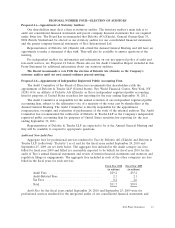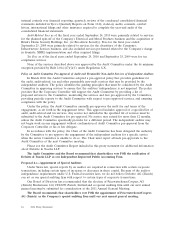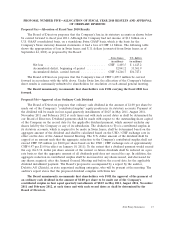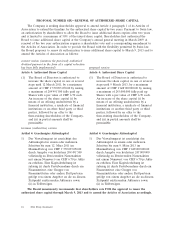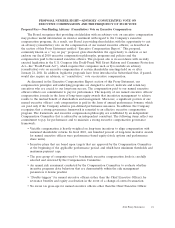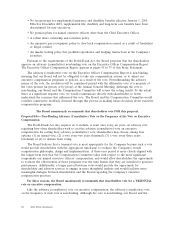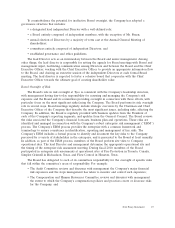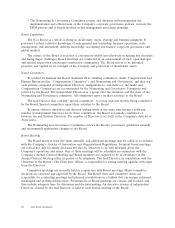ADT 2010 Annual Report Download - page 29
Download and view the complete annual report
Please find page 29 of the 2010 ADT annual report below. You can navigate through the pages in the report by either clicking on the pages listed below, or by using the keyword search tool below to find specific information within the annual report.PROPOSAL NUMBER EIGHT—ADVISORY (CONSULTATIVE) VOTE ON
EXECUTIVE COMPENSATION AND THE FREQUENCY OF SUCH VOTE
Proposal 8(a)—Non-Binding Advisory (Consultative) Vote on Executive Compensation
The Board recognizes that providing stockholders with an advisory vote on executive compensation
may produce useful information on investor sentiment with regard to the Company’s executive
compensation programs. As a result, our Board is providing shareholders with the opportunity to cast
an advisory (consultative) vote on the compensation of our named executive officers, as described in
the section of this Proxy Statement entitled ‘‘Executive Compensation Report.’’ This proposal,
commonly known as a ‘‘say on pay’’ proposal, gives shareholders the opportunity to endorse or not
endorse our fiscal 2010 executive compensation philosophy, programs and policies and the
compensation paid to the named executive officers. The proposal also is in accordance with recently
enacted legislation in the U.S. Congress (the Dodd-Frank Wall Street Reform and Consumer Protection
Act—the ‘‘Dodd-Frank Act’’), which requires that companies such as Tyco include an advisory
(consultative) vote on executive compensation at certain shareholder meetings held on or after
January 21, 2011. In addition, legislative proposals have been introduced in Switzerland that, if passed,
would also require an advisory, or ‘‘consultative,’’ vote on executive compensation.
As discussed in the Executive Compensation Report section of this Proxy Statement, our
compensation principles and underlying programs are designed to attract, motivate and retain key
executives who are crucial to our long-term success. The compensation paid to our named executive
officers reflects our commitment to pay for performance. The majority of our named executive officers’
compensation is made in the form of long-term equity awards that incentivize management to achieve
results to the mutual benefit of shareholders and management. Moreover, a significant portion of our
named executive officers’ cash compensation is paid in the form of annual performance bonuses, which
are paid only if the Company achieves pre-defined performance measures. In addition, the Company
recognizes that a strong governance framework is essential to an effective executive compensation
program. The framework and executive compensation philosophy are established by an independent
Compensation Committee that is advised by an independent consultant. The following items reflect our
commitment to pay for performance and to maintain a strong executive compensation governance
framework:
• Variable compensation is heavily weighted on long-term incentives to align compensation with
sustained shareholder returns. In fiscal 2010, one hundred percent of long-term incentive awards
for named executive officers were performance-based equity (stock options and performance
share units).
• Incentive plans that are based upon targets that are approved by the Compensation Committee
at the beginning of the applicable performance period, and which have minimum thresholds and
maximum payment caps.
• The peer group of companies used to benchmark executive compensation levels is carefully
selected and reviewed by the Compensation Committee.
• An annual risk assessment conducted by the Compensation Committee to evaluate whether
incentive programs drive behaviors that are demonstrably within the risk management
parameters it deems prudent.
• ‘‘Double-triggers’’ for named executive officers (other than the Chief Executive Officer) for
severance benefits and equity acceleration in the event of a change-of-control transaction.
• No excise tax gross-ups for named executive officers other than the Chief Executive Officer.
2011 Proxy Statement 21






